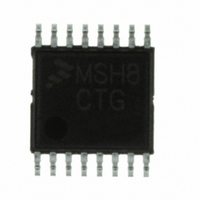MC9S08SH8CTG Freescale Semiconductor, MC9S08SH8CTG Datasheet - Page 26

MC9S08SH8CTG
Manufacturer Part Number
MC9S08SH8CTG
Description
IC MCU 8BIT 8K FLASH 16-TSSOP
Manufacturer
Freescale Semiconductor
Series
HCS08r
Datasheet
1.MC9S08SH4CTJ.pdf
(338 pages)
Specifications of MC9S08SH8CTG
Core Processor
HCS08
Core Size
8-Bit
Speed
40MHz
Connectivity
I²C, LIN, SCI, SPI
Peripherals
LVD, POR, PWM, WDT
Number Of I /o
13
Program Memory Size
8KB (8K x 8)
Program Memory Type
FLASH
Ram Size
512 x 8
Voltage - Supply (vcc/vdd)
2.7 V ~ 5.5 V
Data Converters
A/D 8x10b
Oscillator Type
Internal
Operating Temperature
-40°C ~ 85°C
Package / Case
16-TSSOP
Cpu Family
HCS08
Device Core Size
8b
Frequency (max)
40MHz
Interface Type
I2C/SCI/SPI
Total Internal Ram Size
512Byte
# I/os (max)
13
Number Of Timers - General Purpose
1
Operating Supply Voltage (typ)
3.3/5V
Operating Supply Voltage (max)
5.5V
Operating Supply Voltage (min)
2.7V
On-chip Adc
8-chx10-bit
Instruction Set Architecture
CISC
Operating Temp Range
-40C to 85C
Operating Temperature Classification
Industrial
Mounting
Surface Mount
Pin Count
16
Package Type
TSSOP
Processor Series
S08SH
Core
HCS08
Data Bus Width
8 bit
Data Ram Size
512 B
Maximum Clock Frequency
40 MHz
Number Of Programmable I/os
13
Number Of Timers
3
Operating Supply Voltage
5.5 V
Maximum Operating Temperature
+ 85 C
Mounting Style
SMD/SMT
3rd Party Development Tools
EWS08
Development Tools By Supplier
DEMO9S08SG32, DEMO9S08SG32AUTO, DEMO9S08SG8, DEMO9S08SG8AUTO, DEMO9S08SH32, DEMO9S08SH8
Minimum Operating Temperature
- 40 C
For Use With
DEMO9S08SH8 - BOARD DEMO FOR MC9S08SH FAM
Lead Free Status / RoHS Status
Lead free / RoHS Compliant
Eeprom Size
-
Lead Free Status / Rohs Status
Compliant
Available stocks
Company
Part Number
Manufacturer
Quantity
Price
Company:
Part Number:
MC9S08SH8CTG
Manufacturer:
FREESCALE
Quantity:
12 000
Part Number:
MC9S08SH8CTG
Manufacturer:
FREESCALE
Quantity:
20 000
Part Number:
MC9S08SH8CTGR
Manufacturer:
FREESCALE
Quantity:
20 000
- Current page: 26 of 338
- Download datasheet (4Mb)
Chapter 2 Pins and Connections
2.2.2
Immediately after reset, the MCU uses an internally generated clock provided by the clock source
generator (ICS) module. For more information on the ICS, see
(S08ICSV2).”
The oscillator (XOSC) in this MCU is a Pierce oscillator that can accommodate a crystal or ceramic
resonator. Rather than a crystal or ceramic resonator, an external oscillator can be connected to the EXTAL
input pin.
Refer to
resistors such as carbon composition resistors. Wire-wound resistors, and some metal film resistors, have
too much inductance. C1 and C2 normally should be high-quality ceramic capacitors that are specifically
designed for high-frequency applications.
R
is not generally critical. Typical systems use 1 MΩ to 10 MΩ. Higher values are sensitive to humidity and
lower values reduce gain and (in extreme cases) could prevent startup.
C1 and C2 are typically in the 5-pF to 25-pF range and are chosen to match the requirements of a specific
crystal or resonator. Be sure to take into account printed circuit board (PCB) capacitance and MCU pin
capacitance when selecting C1 and C2. The crystal manufacturer typically specifies a load capacitance
which is the series combination of C1 and C2 (which are usually the same size). As a first-order
approximation, use 10 pF as an estimate of combined pin and PCB capacitance for each oscillator pin
(EXTAL and XTAL).
2.2.3
After a power-on reset (POR), the PTA5/IRQ/TCLK/RESET pin defaults to a general-purpose I/O port
pin, PTA5. Setting RSTPE in SOPT1 configures the pin to be the RESET pin with an open-drain drive
containing an internal pull-up device. After configured as RESET, the pin will remain RESET until the
next POR. The RESET pin when enabled can be used to reset the MCU from an external source when the
pin is driven low.
Internal power-on reset and low-voltage reset circuitry typically make external reset circuitry unnecessary.
This pin is normally connected to the standard 6-pin background debug connector so a development
system can directly reset the MCU system. If desired, a manual external reset can be added by supplying
a simple switch to ground (pull reset pin low to force a reset).
Whenever any non-POR reset is initiated (whether from an external signal or from an internal system), the
RESET pin if enabled is driven low for about 66 bus cycles. The reset circuitry decodes the cause of reset
and records it by setting a corresponding bit in the system reset status register (SRS).
26
F
is used to provide a bias path to keep the EXTAL input in its linear range during crystal startup; its value
Figure 2-5
Oscillator (XOSC)
RESET
This pin does not contain a clamp diode to V
above V
for the following discussion. R
DD
.
MC9S08SH8 MCU Series Data Sheet, Rev. 3
NOTE
S
(when used) and R
DD
Chapter 10, “Internal Clock Source
and should not be driven
F
should be low-inductance
Freescale Semiconductor
Related parts for MC9S08SH8CTG
Image
Part Number
Description
Manufacturer
Datasheet
Request
R
Part Number:
Description:
Manufacturer:
Freescale Semiconductor, Inc
Datasheet:
Part Number:
Description:
Manufacturer:
Freescale Semiconductor, Inc
Datasheet:
Part Number:
Description:
Manufacturer:
Freescale Semiconductor, Inc
Datasheet:
Part Number:
Description:
Manufacturer:
Freescale Semiconductor, Inc
Datasheet:
Part Number:
Description:
Manufacturer:
Freescale Semiconductor, Inc
Datasheet:
Part Number:
Description:
Manufacturer:
Freescale Semiconductor, Inc
Datasheet:
Part Number:
Description:
Manufacturer:
Freescale Semiconductor, Inc
Datasheet:
Part Number:
Description:
Manufacturer:
Freescale Semiconductor, Inc
Datasheet:
Part Number:
Description:
Manufacturer:
Freescale Semiconductor, Inc
Datasheet:
Part Number:
Description:
Manufacturer:
Freescale Semiconductor, Inc
Datasheet:
Part Number:
Description:
Manufacturer:
Freescale Semiconductor, Inc
Datasheet:
Part Number:
Description:
Manufacturer:
Freescale Semiconductor, Inc
Datasheet:
Part Number:
Description:
Manufacturer:
Freescale Semiconductor, Inc
Datasheet:
Part Number:
Description:
Manufacturer:
Freescale Semiconductor, Inc
Datasheet:
Part Number:
Description:
Manufacturer:
Freescale Semiconductor, Inc
Datasheet:











